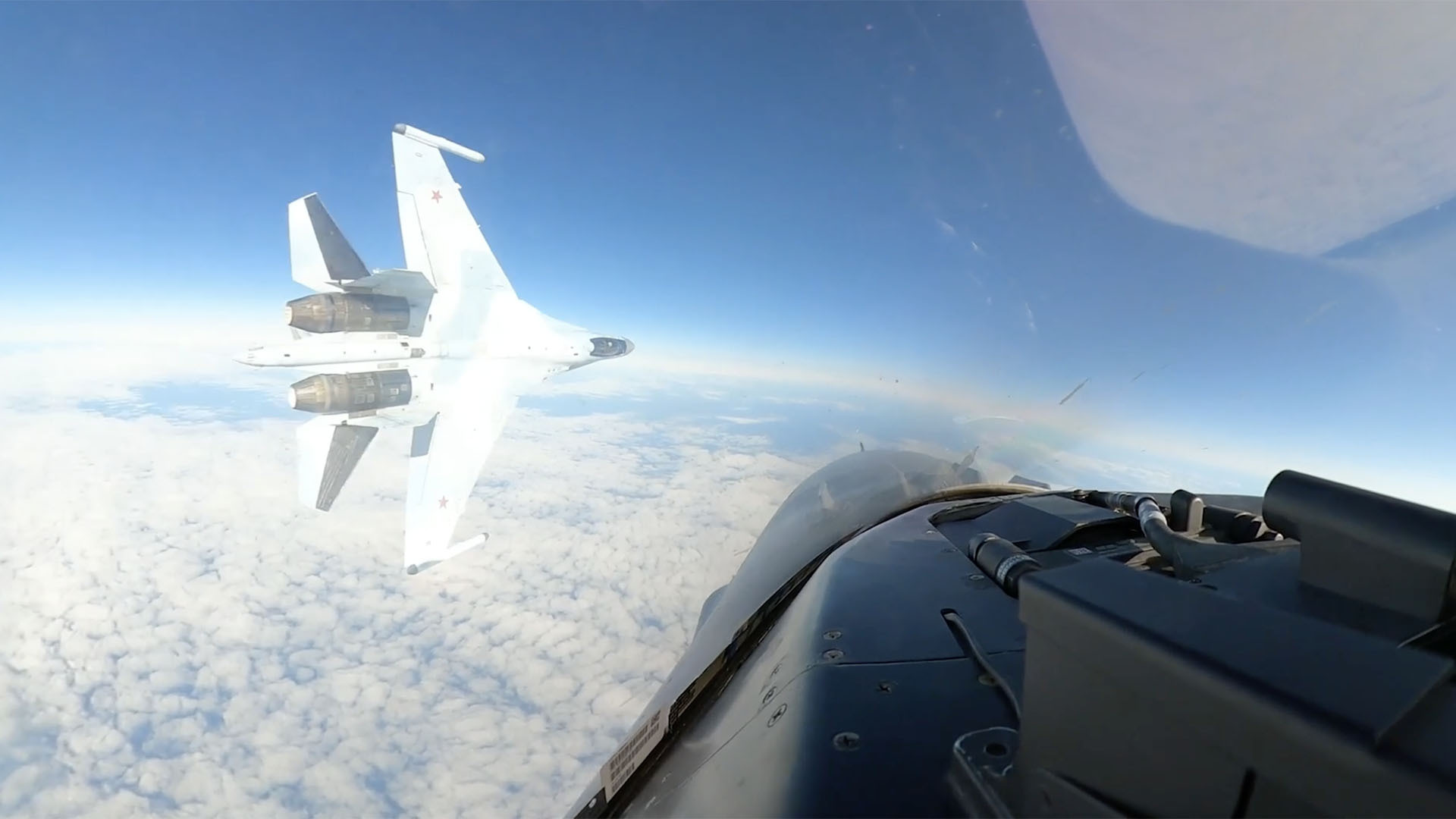
The U.S. military has released video of a Russian Su-35 fighter flying far too close to an American F-16 in the Alaska Air Defense Identification Zone, or ADIZ, an area of international airspace in which aircraft must be identified for national security reasons.
The Sept. 23 incident marked the first time that aircraft from North American Aerospace Defense Command, or NORAD, has had to deal with unsafe and unprofessional Russian conduct since Russia resumed long-range aviation flights in 2007, a NORAD spokesperson told Task & Purpose Russia had suspended such flights in 1992 when the Cold War ended.
Although the U.S. government has accused Russian pilots of conducting dangerous maneuvers near American aircraft elsewhere, the NORAD spokesman said this marks the first time that NORAD has documented unsafe behavior by a Russian aircraft in one of the ADIZs that it enforces.
“The first fighter incursion occurred in 2014 and no unsafe or unprofessional occurrences have been recorded,” the spokesperson said.
The video was taken from inside the cockpit of the F-16 during a routine intercept of a Russian Tu-95 bomber. The Su-35 suddenly cut across the F-16’s nose, forcing the American pilot to bank right.

It appears the Russian pilot conducted a “headbutt” maneuver, which can be used to get another pilot’s attention or harass another aircraft by forcing it to fly through the other plane’s turbulence
“On Monday (Sept. 23), NORAD aircraft flew a safe and disciplined intercept of Russian military aircraft in the Alaskan ADIZ,” Air Force Gen. Gregory M. Guillot, head of U.S Northern Command and North American Aerospace Defense Command, said in a statement. “The conduct of one Russian Su-35 was unsafe, unprofessional, and endangered all — not what you’d see in a professional air force.”
Subscribe to Task & Purpose today. Get the latest military news and culture in your inbox daily.
The reasons why the Russian pilot decided to fly so close to the F-16 remain unclear, said retired Air Force Lt. Gen. David Deptula, dean of the Air Force Association’s Mitchell Institute for Aerospace Studies think tank.
Deptula said he believes the individual Russian pilot decided to cut across the F-16’s nose instead of being ordered to do so.
“It’s a completely unprofessional act,” Deptula told Task & Purpose on Tuesday. “Number two, it indicates a breakdown in the Russian air force’s discipline because there is no purpose for acting in that manner that would be part of direction coming from Russian top command.”
He also noted that the Russian air force is currently committed to the war in Ukraine, “And the last thing it needs to do is to provoke an incident with the United States.”
One reason why the Russian pilot’s maneuver was so reckless is that if the F-16 had decided to turn left instead of continuing his approach to the Russian bomber, the Su-35 and F-16 could have collided, Deptula said.
“I’d like to be in the debrief after that guy landed and hear what he told his squadron commander,” Deptula said, adding that if he were the commander of an American pilot who flew like this, the pilot would be “grounded.”
Since Russia launched its full-scale invasion of Ukraine in February 2022, Russian pilots have harassed U.S. aircraft and ground forces, especially in Syria, where both U.S. and Russian troops are deployed. In March 2023, a Russian fighter ran into an MQ-9 Reaper, causing the U.S. drone to crash into the Black Sea.
The Sept. 23 incident in the Alaskan ADIZ represents “pretty typical Russian unprofessional behavior,” said retired Air Force Gen. Philip Breedlove, who served as head of U.S. European Command and Supreme Allied Commander Europe of NATO Allied Command Operations from 2013 to 2016.
“And the sad news is that the proficiency of the Russian pilots is such that this is much more dangerous than it looks,” Deptula told Task & Purpose. “They don’t get the kind of flying time that would even attempt to make something like this more normalized. Sadly, this is the age we’re in.”
Breedlove said he believes that Russian President Vladimir Putin feels emboldened to challenge the United States by authorizing aggressive actions that fall short of war with NATO countries, such as the incident between the Su-35 and F-16.
He also said that Putin lives by a quote from Vladimir Lenin, the first leader of the Soviet Union: “You probe with bayonets: if you find mush, you push. If you find steel, you withdraw.”
“I think that it’s pretty clear that right now, Russia doesn’t feel hard resistance in its probing outside of NATO,” Breedlove said.
The latest on Task & Purpose
- Command chief fired at Keesler Air Force Base after investigation ‘warranted removal’
- Marine Corps rolls out plan to overhaul marksmanship training for the first time in a century
- Army meets recruiting goal with soldiers who are older or need extra prep
- Nine college lacrosse players hospitalized after workout led by Navy SEAL graduate
- Surge in Marines staying in the Corps past their first enlistment
